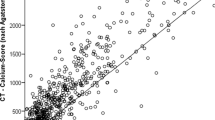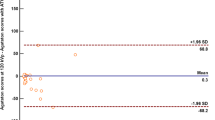Abstract
Objectives
To investigate diagnostic accuracy and radiation dose of high-pitch CT coronary artery calcium scoring (CACS) with tin filtration (Sn100kVp) versus standard 120kVp high-pitch acquisition.
Methods
78 patients (58% male, 61.5±9.1 years) were prospectively enrolled. Subjects underwent clinical 120kVp high-pitch CACS using third-generation dual-source CT followed by additional high-pitch Sn100kVp acquisition. Agatston scores, calcium volume scores, Agatston score categories, percentile-based risk categorization and radiation metrics were compared.
Results
61/78 patients showed coronary calcifications. Median Agatston scores were 34.9 [0.7–197.1] and 41.7 [0.7–207.2] and calcium volume scores were 34.1 [0.7–218.0] for Sn100kVp and 35.7 [1.1–221.0] for 120kVp acquisitions, respectively (both p<0.0001). Bland-Altman analysis revealed underestimated Agatston scores and calcium volume scores with Sn100kVp versus 120kVp acquisitions (mean difference: 16.4 and 11.5). However, Agatston score categories and percentile-based risk categories showed excellent agreement (ĸ=0.98 and ĸ=0.99). Image noise was 25.8±4.4HU and 16.6±2.9HU in Sn100kVp and 120kVp scans, respectively (p<0.0001). Dose-length-product was 9.9±4.8mGy*cm and 40.9±14.4mGy*cm with Sn100kVp and 120kVp scans, respectively (p<0.0001). This resulted in significant effective radiation dose reduction (0.13±0.07mSv vs. 0.57±0.2mSv, p<0.0001) for Sn100kVp acquisitions.
Conclusion
CACS using high-pitch low-voltage tin-filtered acquisitions demonstrates excellent agreement in Agatston score and percentile-based cardiac risk categorization with standard 120kVp high-pitch acquisitions. Furthermore, radiation dose was significantly reduced by 78% while maintaining accurate risk prediction.
Key points
• Coronary artery calcium scoring with tin filtration reduces radiation dose by 78%.
• There is excellent correlation between high-pitch Sn100kVp and standard 120kVp acquisitions.
• Excellent agreement regarding Agatston score categories and percentile-based risk categorization was achieved.
• No cardiac risk reclassifications were observed using Sn100kVp coronary artery calcium scoring.



Similar content being viewed by others
Abbreviations
- BMI:
-
Body mass index
- CACS:
-
Coronary artery calcium scoring
- CAD:
-
Coronary artery disease
- CCTA:
-
Coronary CT angiography
- CI:
-
Confidence interval
- CT:
-
Computed tomography
- CTDI:
-
CT dose index
- DLP:
-
Dose length product
- DSCT:
-
Dual-source CT
- HU:
-
Hounsfield units
- SD:
-
Standard deviation
- SNR:
-
Signal-to-noise ratio
- ROI:
-
Region of interest
References
Agatston AS, Janowitz WR, Hildner FJ, Zusmer NR, Viamonte M Jr, Detrano R (1990) Quantification of coronary artery calcium using ultrafast computed tomography. J Am Coll Cardiol 15:827–832
Bauer RW, Thilo C, Chiaramida SA, Vogl TJ, Costello P, Schoepf UJ (2009) Noncalcified atherosclerotic plaque burden at coronary CT angiography: a better predictor of ischemia at stress myocardial perfusion imaging than calcium score and stenosis severity. AJR Am J Roentgenol 193:410–418
Renker M, Geyer LL, Krazinski AW, Silverman JR, Ebersberger U, Schoepf UJ (2013) Iterative image reconstruction: a realistic dose-saving method in cardiac CT imaging? Expert Rev Cardiovasc Ther 11:403–409
Yin WH, Lu B, Li N et al (2013) Iterative reconstruction to preserve image quality and diagnostic accuracy at reduced radiation dose in coronary CT angiography: an intraindividual comparison. JACC Cardiovasc Imaging 6:1239–1249
Meyer M, Haubenreisser H, Schoepf UJ et al (2014) Closing in on the K edge: coronary CT angiography at 100, 80, and 70 kV-initial comparison of a second- versus a third-generation dual-source CT system. Radiology 273:373–382
Tesche C, De Cecco CN, Vliegenthart R et al (2017) Accuracy and Radiation Dose Reduction Using Low-Voltage Computed Tomography Coronary Artery Calcium Scoring With Tin Filtration. Am J Cardiol 119:675–680
Tesche C, De Cecco CN, Schoepf UJ et al (2017) CT coronary calcium scoring with tin filtration using iterative beam-hardening calcium correction reconstruction. Eur J Radiol 91:29–34
Tesche C, De Cecco CN, Schoepf UJ et al (2017) Iterative beam-hardening correction with advanced modeled iterative reconstruction in low voltage CT coronary calcium scoring with tin filtration: Impact on coronary artery calcium quantification and image quality. J Cardiovasc Comput Tomogr 11:354–359
Hausleiter J, Meyer T, Hermann F et al (2009) Estimated radiation dose associated with cardiac CT angiography. Jama 301:500–507
Koo TK, Li MY (2016) A Guideline of Selecting and Reporting Intraclass Correlation Coefficients for Reliability Research. J Chiropr Med 15:155–163
Bland JM, Altman DG (1986) Statistical methods for assessing agreement between two methods of clinical measurement. Lancet 1:307–310
McClelland RL, Chung H, Detrano R, Post W, Kronmal RA (2006) Distribution of coronary artery calcium by race, gender, and age: results from the Multi-Ethnic Study of Atherosclerosis (MESA). Circulation 113:30–37
Landis JR, Koch GG (1977) An application of hierarchical kappa-type statistics in the assessment of majority agreement among multiple observers. Biometrics 33:363–374
McQuiston AD, Muscogiuri G, Schoepf UJ et al (2016) Approaches to ultra-low radiation dose coronary artery calcium scoring based on 3rd generation dual-source CT: A phantom study. Eur J Radiol 85:39–47
Marwan M, Mettin C, Pflederer T et al (2013) Very low-dose coronary artery calcium scanning with high-pitch spiral acquisition mode: comparison between 120-kV and 100-kV tube voltage protocols. J Cardiovasc Comput Tomogr 7:32–38
Hecht HS, de Siqueira ME, Cham M et al (2015) Low- vs. standard-dose coronary artery calcium scanning. Eur Heart J Cardiovasc Imaging 16:358–363
Nakazato R, Dey D, Gutstein A et al (2009) Coronary artery calcium scoring using a reduced tube voltage and radiation dose protocol with dual-source computed tomography. J Cardiovasc Comput Tomogr 3:394–400
Willemink MJ, Vliegenthart R, Takx RA et al (2014) Coronary artery calcification scoring with state-of-the-art CT scanners from different vendors has substantial effect on risk classification. Radiology 273:695–702
Funding
The authors state that this work has not received any funding.
Author information
Authors and Affiliations
Corresponding author
Ethics declarations
Guarantor
The scientific guarantor of this publication is U. Joseph Schoepf, MD.
Conflict of interest
The authors of this manuscript declare relationships with the following companies: Dr. Schoepf receives institutional research support from Astellas, Bayer, GE, and Siemens Healthineers. Dr. De Cecco receives institutional research support from Siemens Healthineers. Dr. Schoepf has received consulting fees / honoraria from Bayer, Guerbet, and Siemens. Drs. De Cecco and Varga-Szemes have received consulting fees from Guerbet. Dr. P. Apfaltrer receives institutional research support from Siemens Healthineers. The other authors have no conflicts of interest to disclose.
Statistics and biometry
One of the authors has significant statistical expertise.
Informed consent
Written informed consent was waived by the Institutional Review Board.
Ethical approval
Institutional Review Board approval was obtained.
Methodology
• prospective
• diagnostic study
• performed at one institution
Rights and permissions
About this article
Cite this article
Apfaltrer, G., Albrecht, M.H., Schoepf, U.J. et al. High-pitch low-voltage CT coronary artery calcium scoring with tin filtration: accuracy and radiation dose reduction. Eur Radiol 28, 3097–3104 (2018). https://doi.org/10.1007/s00330-017-5249-2
Received:
Revised:
Accepted:
Published:
Issue Date:
DOI: https://doi.org/10.1007/s00330-017-5249-2




